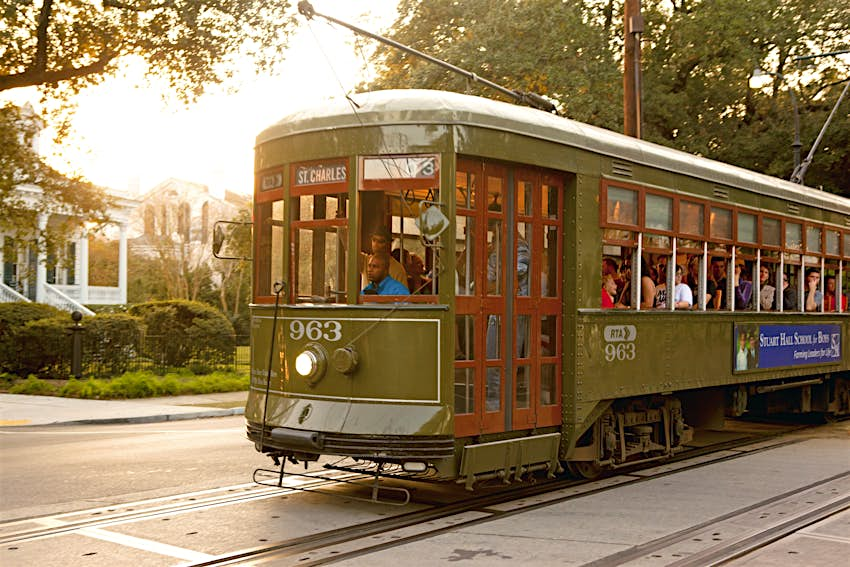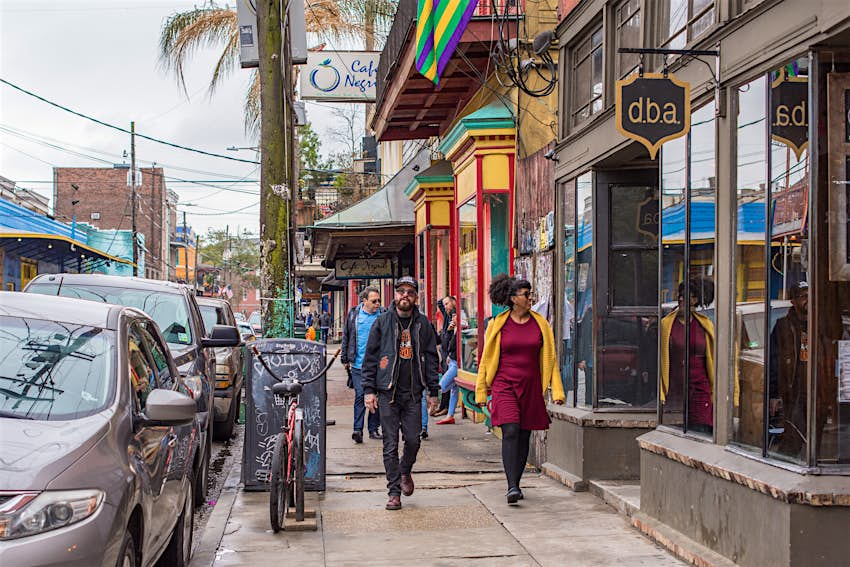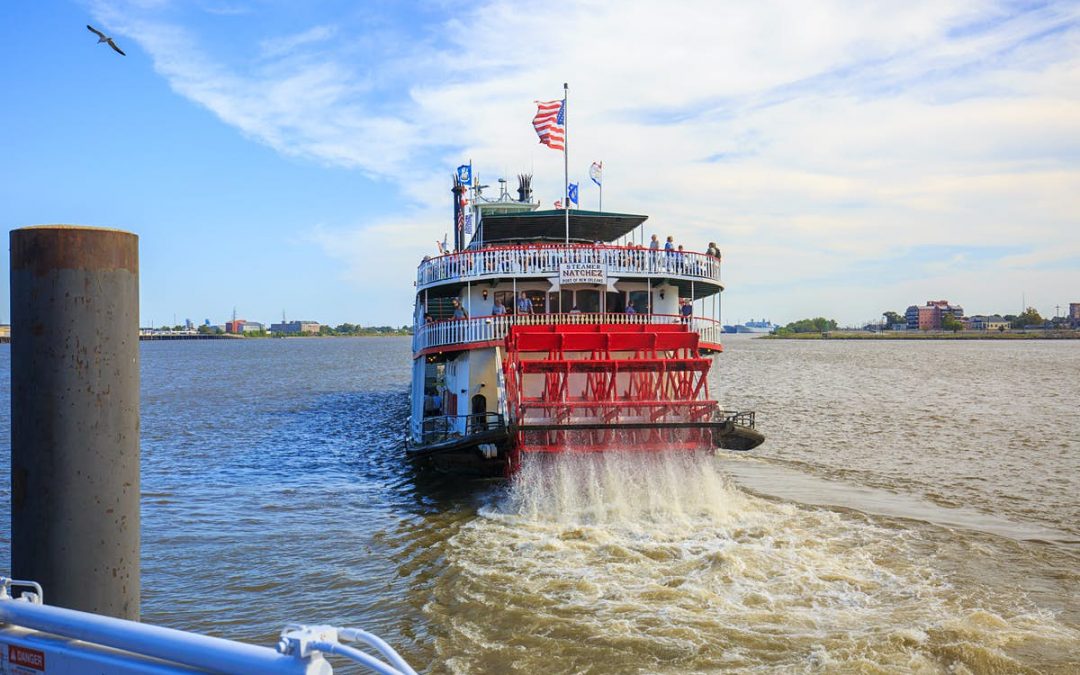[ad_1]
Many who go to New Orleans begin within the French Quarter and by no means depart. And whereas it is smart – the Quarter is likely one of the most stunning slices of preserved structure in North America, and it is dwelling to lots of the metropolis’s nice eating places, bars and music venues – a lot of town’s native life happens exterior of the Quarter’s confines. In the event you’re planning on staying within the Quarter, keep away from the congestion, potholes and lack of parking by getting round on foot. However when you’re trying to discover extra of town, you will want greater than your personal two ft. This is all the pieces it’s good to learn about easy methods to get round in New Orleans.
Editor’s word: throughout COVID-19 there could also be further journey restrictions. Verify the newest steering in New Orleans earlier than planning a visit, and all the time comply with native authorities well being recommendation.

Streetcar
In some ways, the streetcar is the quintessential automobile for New Orleans public transportation: sluggish, fairly and, if not completely environment friendly, extraordinarily atmospheric. There are 4 traces, run by the Regional Transit Authority that serve key routes within the metropolis. Fares price $1.25 – have precise change – or buy a Jazzy Go (one-/three-/five-/31-day limitless rides $3/9/15/55), which can also be good on buses. Jazzy Passes might be bought from streetcar conductors, bus drivers, in Walgreens drugstores and from ticketing machines at RTA shelters alongside Canal St. Streetcars run about each 15 to twenty minutes, leaning towards each half-hour later at night time.
All 4 traces – the Canal Road line, the Riverfront line, the St Charles Ave line and the Rampart-St. Claude line – both run alongside or intersect with Canal Road between the French Quarter and the Central Enterprise District.

Automotive
Downtown on-street parking is usually for short-term use solely. In some components of city, search for solar-powered parking meters. One meter typically serves a whole block, so don’t assume parking is free simply because there’s no meter on the curb instantly beside the place you park. There are additionally every kind of restrictions to do with avenue cleansing that restrict when you possibly can park on sure streets. You’ll want to learn all parking indicators earlier than leaving your automotive. Enforcement is especially environment friendly within the French Quarter, the CBD and the Warehouse District.
Free avenue parking is offered on many blocks within the Decrease Quarter and alongside Esplanade Ave. In any other case, there are many business tons scattered by means of downtown and the French Quarter; anticipate to pay round $25 to $40 per day, and remember the fact that charges skyrocket at night time. Outdoors the Quarter and downtown, parking is a cinch. There’s loads of avenue parking and never many restrictions, though you can find parking meters alongside a lot of Magazine St. Once more, watch out of avenue parking throughout Mardi Gras and Jazz Fest, when police are liable to ticket or tow you for even very minor infractions.
Suggestions for driving: Drivers ought to bear in mind that though cease indicators are set out in residential areas, not everybody obeys them. New Orleanian friendliness might be annoying if folks cease their vehicles in the course of a slim avenue to speak with somebody – each New Orleans driver has a narrative about this incident. Native drivers even have a repute for not turning on their headlights within the occasion of rain or fog.
Taxi
In the event you’re touring alone or at night time, taxis are beneficial. United Cabs is the largest and most dependable firm in New Orleans. You may need to name for a pickup, until you’re in a central a part of the French Quarter, the place it’s comparatively straightforward to flag down a passing cab.
Fares throughout the metropolis begin with a $3.50 flag-fall cost for one passenger (plus $1 for every further passenger). From there it’s 30 cents per 1/8-mile. New Orleans is small, so don’t anticipate fares to high $20. Don’t overlook to tip your driver about 15%.
Widespread ridesharing apps are additionally out there in New Orleans.

Bicycle
Cyclists will discover New Orleans flat and comparatively compact – you possibly can cross the whole lot of city in 45 minutes. Nonetheless, heavy visitors, potholes, slim roads and unsafe neighborhoods current some negatives to biking, and fats tires are a close to necessity. Oppressive summer time warmth and humidity additionally discourage numerous cyclists.
All ferries supply free transportation for bicycles. Buses at the moment are outfitted with bike racks. Solely folding bicycles are permitted on streetcars.
Boat
The most affordable approach to cruise the Mississippi River is aboard the Canal Street Ferry, which operates between Canal St and the West Financial institution neighborhood of Algiers. The ferry is open to pedestrians and cyclists (no vehicles). Have precise change for the fare. Change is not going to be given, and you can’t pay upfront for the return journey.
Guests to New Orleans throughout Mark Twain’s time arrived by boat through the Mississippi River, however the days of paddle steamboats plying the Huge Muddy at the moment are over. One exception: Paddleboat river cruise, which departs from New Orleans and travels upriver to Baton Rouge, returning with stops at plantations and historic websites. In the event you’re into a brief, tourist-oriented sightseeing cruise, short-voyage riverboats nonetheless ply the river.
Bus
The Regional Transit Authority gives bus and streetcar providers. Service is first rate, however we wouldn’t advocate relying solely on public transportation throughout a New Orleans go to, particularly when you’re staying longer than just a few days. Fares are $1.25 plus 25¢ per switch.
No buses run by means of the center of the French Quarter, so most guests solely use them when venturing uptown or out to Metropolis Park.
On foot
As talked about beforehand, when you’re simply exploring the French Quarter, your ft will serve you simply high quality.
Accessible transportation in New Orleans
New Orleans is considerably lax on this division. Sidewalk curbs hardly ever have ramps, and plenty of historic public buildings and inns should not outfitted to fulfill the wants of wheelchair-users. Trendy inns adhere to requirements established by the federal People with Disabilities Act by offering ramps, elevators and accessible loos.
Crimson streetcars on the Canal St, Rampart Riverfront and Loyola-UPT Streetcar traces are accessible to riders with disabilities. A few of the Inexperienced streetcars that journey the St. Charles Avenue line are accessible.
Regional Transit Authority buses supply a carry service; for details about paratransit service (different transportation for many who can’t journey common buses), name RTA Paratransit.
The RTA has additionally partnered with the nonprofit Lighthouse Louisiana to develop the Help Card Program, which advantages riders of public transportation who’re blind, deaf-blind or have low imaginative and prescient.
Get extra journey inspiration, ideas and unique gives despatched straight to your inbox with our weekly newsletter.
[ad_2]
Source link


Neue Kommentare